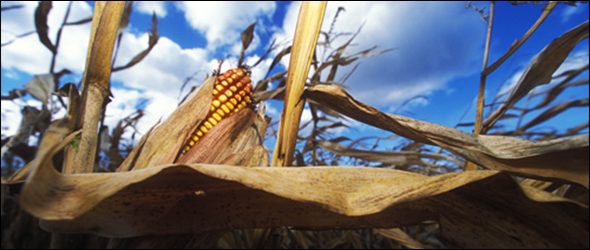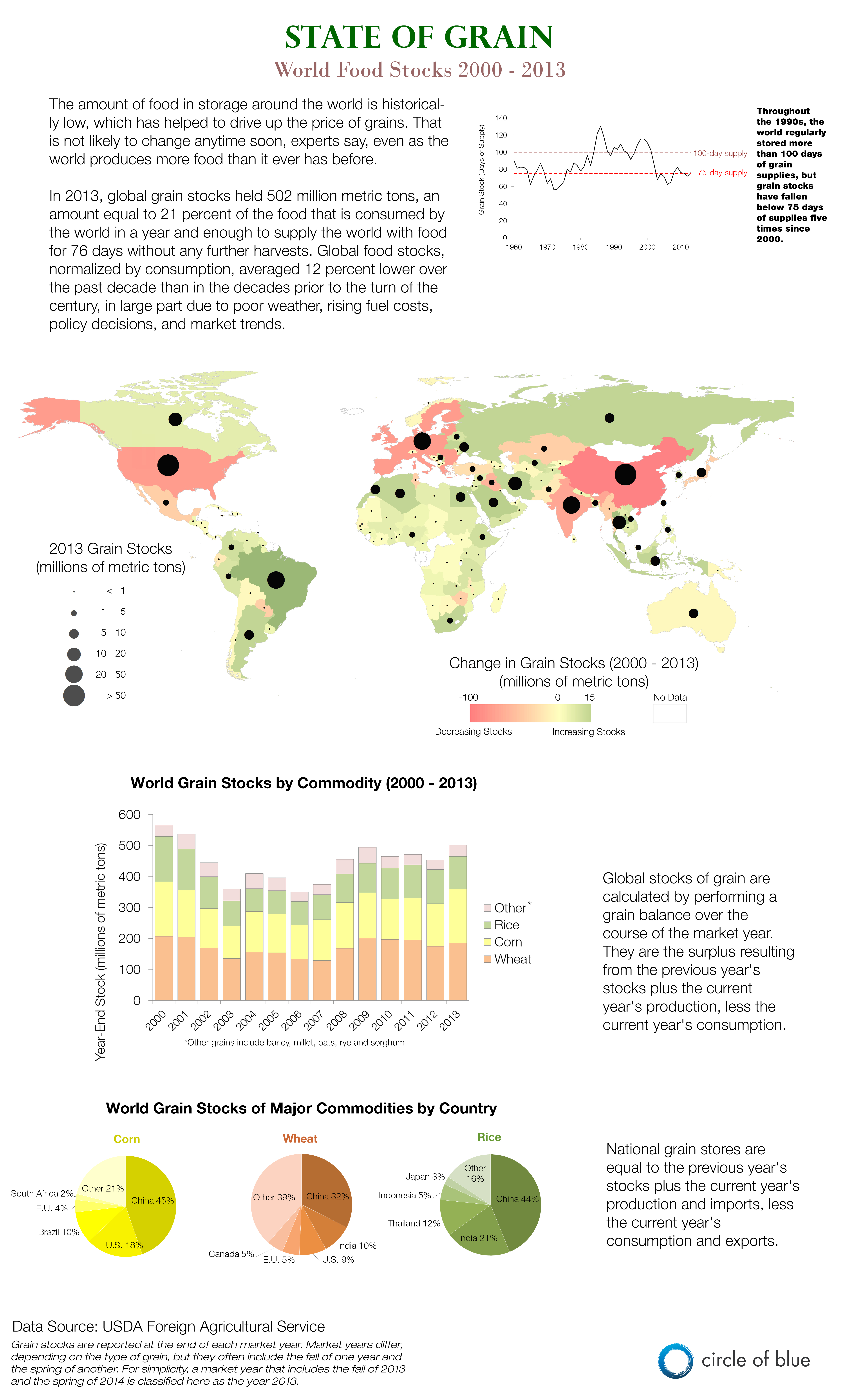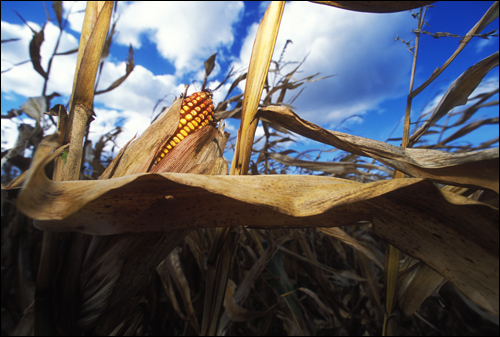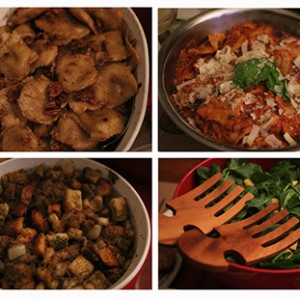World Food Supplies Recover From Drought and Reach 15-Year High
Water scarcity and extreme weather are two reasons that food prices will stay high, however.

By Codi Kozacek
Circle of Blue
World supplies of corn, rice, soybeans, wheat, and other staple grains are forecast to reach their highest levels in 15 years, but experts say the increase will do little to reverse an upward trend in food prices.
The announcement from the United Nations Food and Agriculture Organization (FAO) comes just a year after world food stocks — the amount that countries store in reserve, like a savings account at a bank — dipped to the lowest levels seen since the 2008 global food crisis. Grain stocks are now forecast to reach 624.7 million metric tons by early next year — an amount equal to 25 percent of the food that is consumed by the world in a year and enough to supply the world with food for 91 days without any further harvests.
Last year, in part due to a severe drought that decimated corn crops in the United States, global grain stocks held just 71 days of food. Throughout the 1990s, the world regularly stored more than 100 days of grain supplies, but since 2000, grain stocks have fallen below 75 days of supplies five times. Poor weather, rising fuel costs, policy decisions, and market trends all contributed to the low stocks. Combined with devastating droughts in Australia, Eastern Europe, and the United States, these factors fueled a meteoric rise in food prices over the same period.
The rebound is due to favorable weather in major food-producing countries like the United States, as well as growing productivity in countries like Brazil and Argentina — both of which are challenging the dominance of U.S. export markets for corn and soybeans.
Nonetheless, the amount of food in storage remains historically low, and food prices are still well above those seen before the drop in food supplies. That is not likely to change anytime soon, experts say, even as the world produces more food than it ever has before. The reason is a structural shift in the dynamics of the global food system that is being driven by factors like population growth, increasing water scarcity, more frequent droughts and floods, and fewer countries exporting a growing share of the world’s food.
Low Food Stocks, High Food Prices
The amount of grain that the world stores is not the only factor influencing food prices — depleted grain stocks coincided with a dramatic rise in prices over the past decade. Prices peaked in 2011, prompting riots in parts of Asia and Africa.
“Among the key factors playing a role in creating price volatility between 2007-11 were increasing biofuel production, the medium- and long-term effects of climate change, and higher levels of trading in commodity futures markets,” Maximo Torero wrote in an email to Circle of Blue. Torero is director of the markets, trade, and innovations division at the Washington, D.C.-based International Food Policy Research Institute. “Export restrictions in important food-producing countries also contributed to price increases and market jitters in 2010 and 2011. In addition, historically low stocks and the market concentration of exporting countries play also a crucial role.”

While food prices have declined slowly since then, they are still more than two times higher than in 2000 and are not forecast to drop significantly, even as grain supplies are replenished.
“Our long-term predictions indicate the price trend will continue to be positive mainly because of demand factors and restrictions in potential for expansion of supply,” Torero wrote. “We don’t think prices will go structurally down.”
A growing global population — now expected to reach nearly 11 billion by the end of the century — is the primary force driving demand. In addition, incomes are rising in developing regions of the world like Africa, and biofuels are taking a larger share of crops. Both are creating more demand for food, according to Torero. At the same time, water and land resources are becoming scarcer, there is limited investment in agricultural research, and certain policies restrict the development and application of new science and technology, he explained.
Together, these factors could serve to keep food supplies relatively tight while climate change increases the likelihood of weather extremes — like drought, floods and heat waves — that can push food prices higher.
Food Exports: Controlled by Fewer Countries and Subject to Weather
“For the market to function effectively, the food system must hold a minimum level of grain stocks to be able to respond to unexpected shocks, such as bad weather, and allow for the transport, marketing, and processing of grains,” Torero wrote. “Given the current low levels, sometimes only a small dip in grain stocks leads to problems.”
There is a fine line between having adequate grain stocks and having too little grain stored in reserve, he added.
“In 2007–08 grain stocks were only about 60 million [metric] tons less than in 2004–05, representing a decline of just 2.7 percent of global production,” Torero wrote. “But when prices rose sharply in 2007–08, this difference in grain stocks was enough to contribute to serious price increases, especially for commodities whose production is concentrated in just a few countries, such as rice.”
–Maximo Torero, director
Markets, Trade, and Innovations
International Food Policy Research Institute
China, India, and Thailand hold most of the world’s rice, respectively storing 44 percent, 21 percent, and 12 percent of global rice stocks in 2013, according to data compiled by the United States Department of Agriculture’s Foreign Agricultural Service.
This is true for more commodities than just rice, though.
The world’s food supply is becoming even more vulnerable to extreme weather, because it is being grown in a shrinking number of countries. For example, the top five countries exporting each major commodity control approximately 84 percent of corn exports, 95 percent of paddy rice exports, 70 percent of soybean exports, and 63 percent of wheat exports, according to Torero.
“Given these high levels of concentration, the world’s capacity to cope with shocks is limited,” he wrote. “Any incidence of poor weather or other production shock in these countries will immediately affect global prices and price volatility. Similarly, any policy changes — such as trade bans, customs taxes, or other restrictions on exports — in any of the top exporters will significantly affect the levels and volatility of food.”
That was the case in both 2007, when drought destroyed Australia’s rice crop, and 2012, when drought wiped out the U.S. corn crop. The 2012 drought led to a drop of 5.8 million metric tons in U.S. corn stocks, for example.
U.S. Corn Makes A Comeback
“Quite frankly, the old adage is true: rain makes grain,” Paul Bertels said in an interview with Circle of Blue. Bertels is vice president of production and utilization at the Missouri-based National Corn Growers Association.
This year, good weather has put the United States on track to reach not only a record harvest — the total amount of corn grown — but also record yields, the amount of corn grown per acre of land. Farmers are expected to harvest 365.9 million metric tons of corn, with yields of 4.4 metric tons per acre.
–Paul Bertels, vice president
Production and Utilization
National Corn Growers Association
The quick turnaround from the drought-ravaged 2012 crop is largely due to the record-high corn prices that the drought inspired. Farmers planted more corn to take advantage of the high prices they received, leading to a quick bump in supplies. Corn prices are now about half what they were in 2012, and some farmers are consequently turning to soybeans instead, according to Bertels.
While some measures can be used to guard against dry weather — such as switching from corn to more drought-tolerant crops like soybeans and sorghum — farmers remain at the mercy of the weather.
“Rarely do we know a drought is coming,” Bertels said. “I’ve seen dry springs that turn into wet summers, and wet springs that turn into dry summers. It’s a bit of a gamble. You never know what weather is going to be.”
Infographic by Kaye LaFond, a Circle of Blue reporter. Photo by J. Carl Ganter, Circle of Blue’s director. Reach them at carl.ganter@circleofblue.org and kmlafond@mtu.edu.
A news correspondent for Circle of Blue based out of Hawaii. She writes The Stream, Circle of Blue’s daily digest of international water news trends. Her interests include food security, ecology and the Great Lakes.
Contact Codi Kozacek









Leave a Reply
Want to join the discussion?Feel free to contribute!